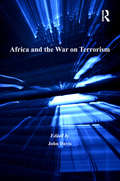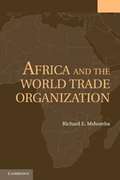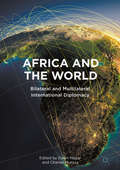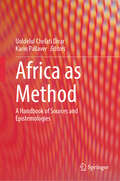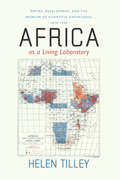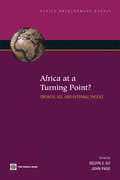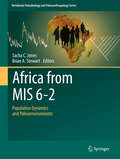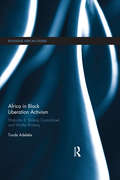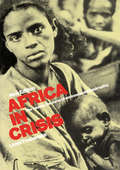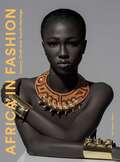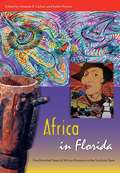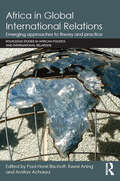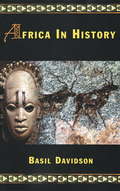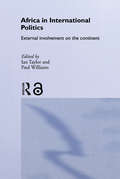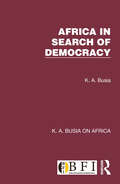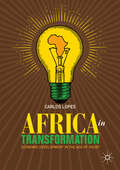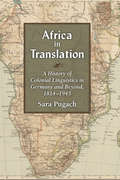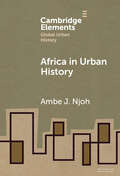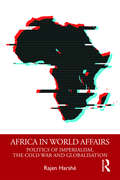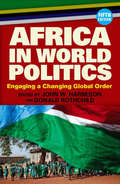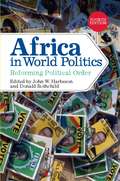- Table View
- List View
Africa and the War on Terrorism
by John DavisAbject poverty and official corruption make parts of Africa a very attractive destination for terrorist organizations. Opportunities have developed during the pre- and post-9/11 periods in Africa for the recruitment of terrorists, attainment of bases of operations and sources of funding for Al Qaeda or its affiliated terror groups. This comprehensive volume provides an extensive examination of major terrorist events in Africa. It highlights internal and external indices to illustrate why Africa is so ripe for terrorism, ostensibly in terms of recruitment as well as attainment and sources of funding due to the continent's continuing poverty and corruption. The volume will prove indispensable reading for anyone researching security issues, political sociology and African studies.
Africa and the World Trade Organization
by Richard E. MshombaMshomba provides a systematic study of Africa as it relates to the World Trade Organization. He examines the WTO's enforcement mechanism; the WTO's broadened mandate, illustrated by the Agreement on Trade-Related Intellectual Property Rights; agriculture in the Doha Round; issues relating to transparency in government procurement; and the endeavor to streamline assistance to developing countries through an "Aid for Trade" initiative. The author integrates theory and practice, with a clear presentation of important economic concepts. He provides a rigorous analysis of key issues and proposals. He presents African countries as having an important role to play in the WTO, especially as they actively engage in bargaining through various coalitions. Mshomba acknowledges that WTO negotiations will always be complex and at times contentious due to wide economic and political differences between countries. He views the differences, however, as creating opportunities for a mutually beneficial exchange of goods, services, and ideas.
Africa and the World: Bilateral and Multilateral International Diplomacy
by Dawn Nagar Charles MutasaThis book probes key issues pertaining to Africa's relations with global actors. It provides a comprehensive trajectory of Africa's relations with key bilateral and major multilateral actors, assessing how the Cold War affected the African state systems' political policies, its economies, and its security. Taken together, the essays in this volume provide a collective understanding of Africa's drive to improve the capacity of its state of global affairs, and assess whether it is in fact able to do so.
Africa as Method: A Handbook of Sources and Epistemologies
by Karin Pallaver Uoldelul Chelati DirarThis methods handbook investigates the multiple sources and interdisciplinary methodologies employed by scholars working on Africa. It illuminates how scholars of Africa locate, select, interpret, and combine sources to reconstruct Africa’s past. Each contributor presents a specific typology of source or body of sources. Focusing on specific case studies, the chapters offer a broad overview of the methods and sources employed by historians, anthropologists, linguists, and related disciplines in the humanities and social sciences, working on Africa. The topics covered are diverse and include the significance of oral sources and how they relate to written sources; the perspectives provided by female writings on and from Africa; the relevance of Islamic court records for the study of Africa; the use of songs and poetry for the understanding of contemporary political protests; the employment of photographs and other visual sources for the study of the African past; how new sources or new interpretations of existing ones can provide different historical periodization; and finally, how biographies and autobiographies, including personal experiences with fieldwork in Africa, can contribute to shed light on Africa’s past. The book is a valuable resource for graduate students and academics interested in doing research on Africa. It provides a sweeping but rich understanding of the methodologies in the field of African studies, and for historians in general. Ultimately, this book contends that the specific methodologies developed for the study of Africa are relevant not only for the understanding of the continent itself, but can also contribute significantly to the historical method more widely.
Africa as a Living Laboratory: Empire, Development, and the Problem of Scientific Knowledge, 1870–1950
by Helen TilleyTropical Africa was one of the last regions of the world to experience formal European colonialism, a process that coincided with the advent of a range of new scientific specialties and research methods. Africa as a Living Laboratory is a far-reaching study of the thorny relationship between imperialism and the role of scientific expertise—environmental, medical, racial, and anthropological—in the colonization of British Africa. A key source for Helen Tilley’s analysis is the African Research Survey, a project undertaken in the 1930s to explore how modern science was being applied to African problems. This project both embraced and recommended an interdisciplinary approach to research on Africa that, Tilley argues, underscored the heterogeneity of African environments and the interrelations among the problems being studied. While the aim of British colonialists was unquestionably to transform and modernize Africa, their efforts, Tilley contends, were often unexpectedly subverted by scientific concerns with the local and vernacular. Meticulously researched and gracefully argued, Africa as a Living Laboratory transforms our understanding of imperial history, colonial development, and the role science played in both.
Africa at a Turning Point? Growth, Aid, and External Shocks
by John Page Delfin Sia GoSince the mid-1990s, sub-Saharan Africa has experienced an acceleration of economic growth that has produced rising incomes and faster human development. However, this growth contrasts with the continent's experience between 1975 and 1995, when it largely missed out on two decades of economic progress. This disparity between Africa's current experience and its history raises questions about the continent's development. Is there a turnaround in Africa's economy? Will growth persist? 'Africa at a Turning Point?' is a collection of essays that analyzes three interrelated aspects of Africa's recent revival. The first set of essays examines Africa's recent growth in the context of its history of growth accelerations and collapses. It seeks to answer such questions as, is Africa at a turning point? Are the economic fundamentals finally pointing toward more sustainable growth? The second set of essays looks at donor flows, which play a large role in Africa's growth. These essays focus on such issues as the management and delivery of increased aid, and the history and volatility of donor flows to Africa. The third set of essays considers the recent impact of one persistent threat to sustained growth in Africa: commodity price shocks, particularly those resulting from fluctuations in oil prices.
Africa for Kids: Exploring a Vibrant Continent - 19 Activities
by Harvey CrozeFor ages 9-12. Africa is brought to life in this imaginative look at the plants, animals, and people that make it such a fascinating continent. Studies of both traditional tribes and modern African cities showcase Africa's diversity, and authentic activities allow kids to dive into the rich culture by making a Maasai bivouac shelter, writing a fable in the African style, working as a field biologist, making a ritual elephant mask, and learning to tie an African Kanga dress. This cross-cultural study also shows kids what challenges Africa faces today while giving them a look at what it is like to live on this interesting continent.
Africa for Kids: Exploring a Vibrant Continent, 19 Activities (For Kids series)
by Harvey CrozeAfrica is brought to life in this imaginative look at the plants, animals, and people that make it such a fascinating continent. Studies of both traditional tribes and modern African cities showcase Africa's diversity, and authentic activities allow kids to dive into the rich culture by making a Maasai bivouac shelter, writing a fable in the African style, working as a field biologist, making a ritual elephant mask, and learning to tie an African Kanga dress. This cross-cultural study also shows kids what challenges Africa faces today while giving them a look at what it is like to live on this interesting continent.
Africa from MIS 6-2: Population Dynamics and Paleoenvironments (Vertebrate Paleobiology and Paleoanthropology)
by Sacha C. Jones Brian A. StewartBringing together archaeological, paleoenvironmental, paleontological and genetic data, this book makes a first attempt to reconstruct African population histories from out species' evolution to the Holocene. Africa during Marine Isotope Stages (MIS) 6 to 2 (~190-12,000 years ago) witnessed the biological development and behavioral florescence of our species. Modern human population dynamics, which involved multiple population expansions, dispersals, contractions and extinctions, played a central role in our species' evolutionary trajectory. So far, the demographic processes - modern human population sizes, distributions and movements - that occurred within Africa during this critical period have been consistently under-addressed. The authors of this volume aim at (1) examining the impact of this glacial-interglacial- glacial cycle on human group sizes, movements and distributions throughout Africa; (2) investigating the macro- and micro-evolutionary processes underpinning our species' anatomical and behavioral evolution; and (3) setting an agenda whereby Africa can benefit from, and eventually contribute to, the increasingly sophisticated theoretical and methodological palaeodemographic frameworks developed on other continents.
Africa in Black Liberation Activism: Malcolm X, Stokely Carmichael and Walter Rodney (Routledge African Studies)
by Tunde AdelekeThis book revisits and analyzes three of the most accomplished twentieth century Black Diaspora activists: Malcolm X (1925–1965), Stokely Carmichael (1941–1998) and Walter Rodney (1942–1980). All three began their careers in the Diaspora and later turned toward Africa. This became the foundation for developing and solidifying a global force that would advance the struggles of Africans and people of African descent in the Diaspora. Adeleke engages and explores this “African-centered” discourse of resistance which informed the collective struggles of these three men. The book illuminates shared and unifying attributes as well as differences, presenting these men as unified by a continuum of struggle against, and resistance to, shared historical and cultural challenges that transcended geographical spaces and historical times. Africa in Black Liberation Activism will be of interest to scholars and students of African-American history, African Studies and the African Diaspora.
Africa in Crisis: The Causes and Cures of Environmental Bankruptcy
by Lloyd TimberlakeThe first edition of this incisive text on the problems of drought and famine facing Africa won worldwide critical acclaim. Revised with a new introduction, Lloyd Timberlake's bestselling study is invaluable reading for anyone interested in Africa.
Africa in Fashion: Luxury, Craft and Textile Heritage
by Ken Kweku NimoAfrica in Fashion explores the kaleidoscope of craft cultures that have shaped African fashion for centuries and captures the intriguing stories of contemporary and avant-garde African brands.Part One looks at Africa's rich cultural heritage and place in the network of global fashion. The first chapter retells the history of African fashion, exploring Africa's textile traditions, artisanship and role as a global resource. The second chapter presents a New Africa and examines the promise and potential of Africa's markets, while challenging stereotypes and the concept of European hegemony particularly in the realm of luxury fashion. It also spotlights Africa's unique position as the global industry shifts towards a more sustainable future. Part Two ushers the reader into the spectacular world of African fashion today. It showcases a carefully curated set of the continent's most dynamic brands and, through interviews with prominent and inspiring designers, offers rare insight into their ethos and design practice. Covering unisex fashion, menswear, womenswear, accessories and jewellery the brands are each purposefully selected to contribute uniquely to the mosaic of Africa evolving creative landscape.
Africa in Fashion: Luxury, Craft and Textile Heritage
by Ken Kweku NimoAfrica in Fashion explores the kaleidoscope of craft cultures that have shaped African fashion for centuries and captures the intriguing stories of contemporary and avant-garde African brands.Part One looks at Africa's rich cultural heritage and place in the network of global fashion. The first chapter retells the history of African fashion, exploring Africa's textile traditions, artisanship and role as a global resource. The second chapter presents a New Africa and examines the promise and potential of Africa's markets, while challenging stereotypes and the concept of European hegemony particularly in the realm of luxury fashion. It also spotlights Africa's unique position as the global industry shifts towards a more sustainable future. Part Two ushers the reader into the spectacular world of African fashion today. It showcases a carefully curated set of the continent's most dynamic brands and, through interviews with prominent and inspiring designers, offers rare insight into their ethos and design practice. Covering unisex fashion, menswear, womenswear, accessories and jewellery the brands are each purposefully selected to contribute uniquely to the mosaic of Africa evolving creative landscape.
Africa in Florida: Five Hundred Years of African Presence in the Sunshine State
by Amanda B. Carlson Robin Poynor"An inspiring, original, and significant work that takes our notions of 'diaspora' to exciting places and offers new and thoughtful data on the presence and impact of 'Africa' in Florida history, lives, and objects. Africa in Florida is an important contribution to American history and to the continuing and transforming histories of African diasporas and Africa itself. "--Henry John Drewal, editor of Sacred Waters "Fascinating. Indispensable. With contributions by excellent scholars in the field of African and African diaspora studies and cultural studies, the volume provides diverse meanings and interpretations of contacts among Africans from the continent, Europeans, and indigenous people of Florida that resulted in works of creative arts, language, music, and food. "--Jacob K. Olupona, author of City of 201 Gods Over the course of centuries, immigrants from numerous countries in contemporary Africa have influenced the Sunshine State's history and culture. Through a critical evaluation of the influences and effects of the numerous African and African-influenced cultures that have been a part of the state's history, this collection of essays and art explores how Florida both shapes and is shaped by the multiple African diasporas that move through it. Africa in Florida challenges the way American history and southern studies have characterized African contributions to the development of the United States by showing how Africans, both free and enslaved, asserted themselves as explorers, farmers, slave owners, artists, and more.
Africa in Global International Relations: Emerging approaches to theory and practice (Routledge Studies in African Politics and International Relations)
by Amitav Acharya Kwesi Aning Paul-Henri BischoffRecent scholarship in International Relations (IR) has started to study the meaning and implications of a non-Western world. With this comes the need for a new paradigm of IR theory that is more global, open, inclusive, and able to capture the voices and experiences of both Western and non-Western worlds. This book investigates why Africa has been marginalised in IR discipline and theory and how this issue can be addressed in the context of the emerging Global IR paradigm. To have relevance for Africa, a new IR theory needs to be more inclusive, intellectually negotiated and holistically steeped in the African context. In this innovative volume, each author takes a critical look at existing IR paradigms and offers a unique perspective based on the African experience. Following on from Amitav Acharya and Barry Buzan’s work, Non-Western International Relations Theory, it develops and advances non-Western IR theory and the idea of Global IR. This volume will be of key interest to scholars and students of African politics, international relations, IR theory and comparative politics.
Africa in History
by Basil DavidsonThe classic history of Africa from the green Sahara and the Iron Age through the 20th century.Basil Davidson's Africa in History was a landmark in the restoration of African history. For centuries the myth had prevailed that Africa had no history prior to direct contact with European "civilization". This new edition of Basil Davidson's book not only eradicated these myths, but takes account of much of the most recent scholarship about native African civilizations.
Africa in International Politics: External Involvement on the Continent (Routledge Advances in International Relations and Global Politics)
by Paul Williams Ian TaylorLocating Africa on the global stage, this book examines and compares external involvement in the continent, exploring the foreign policies of major states and international organizations towards Africa. The contributors work within a political economy framework in order to study how these powers have attempted to stimulate democracy, peace and prosperity in the context of neo-liberal hegemony and ask whom these attempts have benefited and failed.
Africa in Search of Democracy (K. A. Busia on Africa)
by K. A. BusiaOriginally published in 1967, reissued now with a new introduction, Africa in Search of Democracy in the author’s words was ‘a humble contribution to Africa’s search for political wisdom whereby to avoid destruction’. Written by the author during his time in voluntary exile, he was leader of the Parliamentary Opposition and of the United Party in Ghana which opposed the tyrannical rule of Nkrumah and his Convention People’s Party. In this book he proposed to examine the problems facing contemporary Africa within the context of the search for democracy; that is, for the establishment of societies which provide the best possible conditions for individual as well as social development within the widest measure of democratic freedom. The burning questions of nation building, of modernization, of raising standards of living, of achieving African unity, or harmonizing race relations and world peace, are discussed in relation to the quest for democracy.
Africa in Transformation: Economic Development in the Age of Doubt
by Carlos Lopes“Lopes brings his rigour, insight, and experience to this timely new book, presenting a compelling rethink of traditional development models in Africa and the need to seize on transformational change to build a sustainable future for the continent."—Kofi Annan, former United Nations Secretary General “Some readers will enjoy Lopes’ eclectic brilliance and breath-taking culture. Others will salute his ability to bring compelling new angles to every topic. Everyone will be impressed with his craftsmanship, his rich and multi-faceted approach to development, and his high ethical standards. It is impossible to read this jewel book and not feel smarter.”—Célestin Monga, African Development Bank’s Vice President and Chief Economist “Drawing on his distinguished academic career, policy experience at the highest level, and deep love of the continent, Lopes provides a visionary analysis of Africa's current problems and future prospects. This book provides a highly unusual combination of intellectualism and hard-nosed pragmatism. A singular achievement.” —Ha-Joon Chang, University of Cambridge, UK“Thorough, thought-provoking, and beyond rhetoric: definitely a must-read for anyone who wants to understand Africa’s present and future.”—Enrico Letta, former Prime Minister of Italy, Dean of the Paris School of International Affairs, Sciences Po, France Lopes delivers an overview of the critical development issues facing the African continent today. He offers readers a blueprint of policies to address issues, and an intense, heartfelt meditation on the meaning of economic development in the age of democratic doubts, identity crises, global fears and threatening issues of sustainability.
Africa in Translation: A History of Colonial Linguistics in Germany and Beyond, 1814-1945
by Sara Pugach"Africa in Translationis a thoughtful contribution to the literature on colonialism and culture in Germany and will find readers in the fields of German history and German studies as well as appealing to audiences in the large and interdisciplinary fields of colonialism and postcolonialism. " ---Jennifer Jenkins, University of Toronto The study of African languages in Germany, or Afrikanistik, originated among Protestant missionaries in the early nineteenth century and was incorporated into German universities after Germany entered the "Scramble for Africa" and became a colonial power in the 1880s. Despite its long history, few know about the German literature on African languages or the prominence of Germans in the discipline of African philology. InAfrica in Translation: A History of Colonial Linguistics in Germany and Beyond, 1814--1945, Sara Pugach works to fill this gap, arguing that Afrikanistik was essential to the construction of racialist knowledge in Germany. While in other countries biological explanations of African difference were central to African studies, the German approach was essentially linguistic, linking language to culture and national identity. Pugach traces this linguistic focus back to the missionaries' belief that conversion could not occur unless the "Word" was allowed to touch a person's heart in his or her native language, as well as to the connection between German missionaries living in Africa and armchair linguists in places like Berlin and Hamburg. Over the years, this resulted in Afrikanistik scholars using language and culture rather than biology to categorize African ethnic and racial groups. Africa in Translationfollows the history of Afrikanistik from its roots in the missionaries' practical linguistic concerns to its development as an academic subject in both Germany and South Africa throughout the nineteenth and twentieth centuries. Sara Pugach is Assistant Professor of History at California State University, Los Angeles. Jacket image: Perthes, Justus. Mittel und Süd-Afrika. Map. Courtesy of the University of Michigan's Stephen S. Clark Library map collection.
Africa in Urban History (Elements in Global Urban History)
by Ambe J. NjohThis Element in Global Urban History seeks to promote understanding of the urban history of Africa. It does so by undertaking four main tasks. Firstly, it employs race, ethnicity, class, and conflict theory as conceptual frameworks to analyze the spatial structures, social, and political-economic dynamics of African cities from global, comparative, and transnational perspectives. Secondly, it proposes a new typology of the continent's cities. Thirdly, it identifies and draws into focus an important but oft-ignored part of Africa's urban history, namely Indigenous cities. It focuses more intensely on the few that still exist to date. Fourthly, it employs conflict, functional, and symbolic interactionist theories as well as elements of the race ideology to explain the articulation of racism, ethnicity, and classism in the continent's urban space. This is done mainly but not exclusively from historical perspectives.
Africa in World Affairs: Politics of Imperialism, the Cold War and Globalisation
by Rajen HarshéAfrica finds itself at the centre stage of world politics in the twenty-first century. To truly determine its rising influence and role in world affairs would mean unravelling the politics of imperialism, the Cold War and globalisation. Going beyond Euro-American perspectives, this book presents a comprehensive study of Africa and its role in world politics. Africa in World Affairs: • Closely examines the transition of Africa in its colonial and post-colonial phases; • Explores the intellectual history of modern Africa through liberation struggles, social movements, leaders and thinkers; • Investigates the continent’s relationships with former colonial powers such as Britain, France and Portugal; untangles complexities of French neo-colonialism and sheds light on the role of the superpower, such as the USA and major and rising powers like China and India; • Highlights complex and wide-ranging diversities of the region, and the ways in which it continues to negotiate with issues of modernity, racism and globalisation. A core text on Africa and the world, this book will be indispensable for students of African studies, politics and international relations, and history. It will also be a must-read for policymakers, diplomats and government think tanks.
Africa in World Politics
by Donald Rothchild John W HarbesonIn this fully revised edition top scholars in African politics address the effects that major currents in Africa and world politics have upon each other and explore the ramifications of this interconnection for contemporary theories of international and comparative politics.The fifth edition focuses on engaging a changing world order. The nation-state as we know it is a legacy of European rule in Africa, and the primacy of the nation-state remains the bedrock of most contemporary theories of international relations. Yet in the fifth decade of Africa's independence, this colonial inheritance has been challenged as never before by state weakness, internal and inter-state conflict, new gains in economic development, large investments by China and other G-20 countries, and internal and external demands for economic and political reform, with potentially far-reaching implications. Including six new chapters on warfare, bilateral vs. multilateral peacekeeping, Sudan, the Great Lakes Crisis, and China and Africa, this text remains an invaluable resource for students of African and world politics.
Africa in World Politics
by Donald Rothchild John W HarbesonIn this fully revised edition top scholars in African politics address the effects that major currents in Africa and world politics have upon each other and explore the ramifications of this interconnection for contemporary theories of international and comparative politics.The fourth edition focuses on issues of reforming and strengthening states and their economies in sub-Saharan Africa. The nation-state as we know it is a legacy of European rule in Africa, and the primacy of the nation-state remains a bedrock of most contemporary theories of international relations. Yet in the fifth decade of Africa's independence, this colonial inheritance has been challenged as never before by state weakness, internal and inter-state conflict, and internal and external demands for economic and political reform, with potentially far-reaching implications. Including new readings on the AIDS crisis in Africa and the regional war on terrorism, this text remains an invaluable resource for students of African and world politics.
Africa in World Politics
by Donald Rothchild John W HarbesonIn this fully revised edition top scholars in African politics address the effects that major currents in Africa and world politics have upon each other and explore the ramifications of this interconnection for contemporary theories of international and comparative politics.The fourth edition focuses on issues of reforming and strengthening states and their economies in sub-Saharan Africa. The nation-state as we know it is a legacy of European rule in Africa, and the primacy of the nation-state remains a bedrock of most contemporary theories of international relations. Yet in the fifth decade of Africa's independence, this colonial inheritance has been challenged as never before by state weakness, internal and inter-state conflict, and internal and external demands for economic and political reform, with potentially far-reaching implications. Including new readings on the AIDS crisis in Africa and the regional war on terrorism, this text remains an invaluable resource for students of African and world politics.
